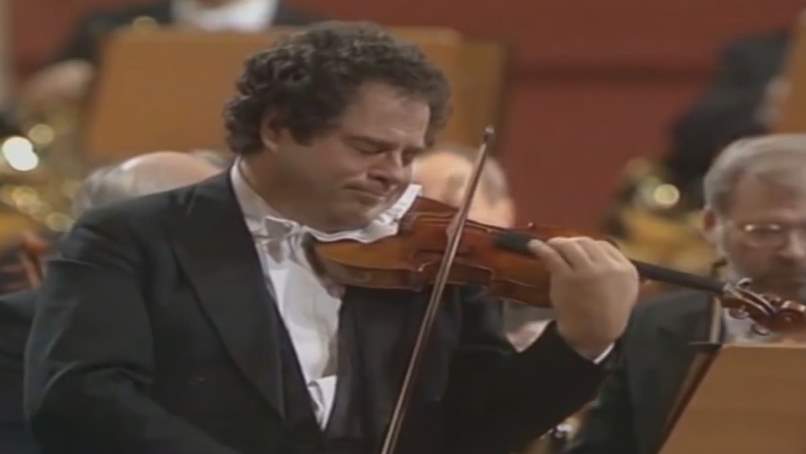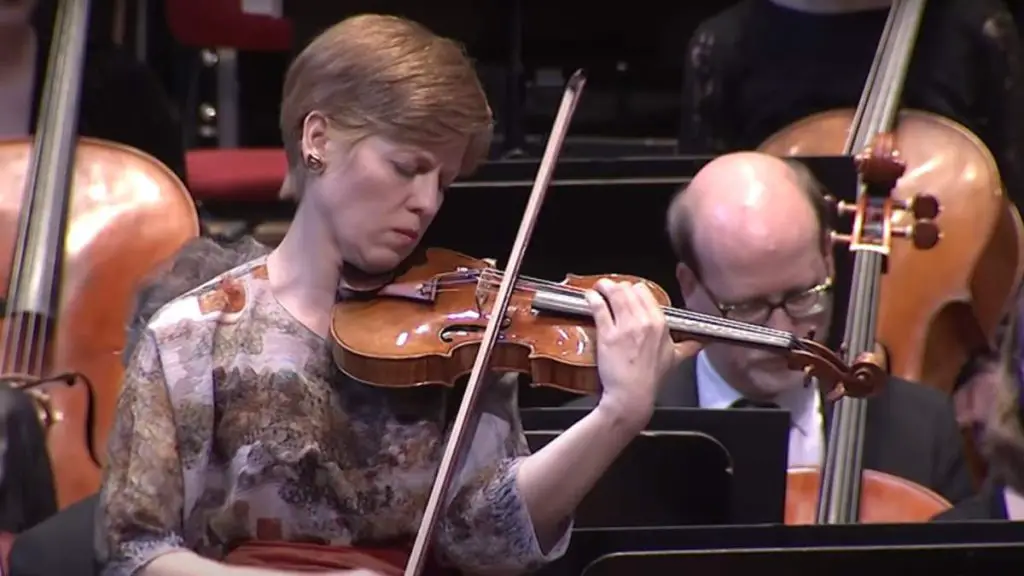Accompanied by the Poznań Philharmonic Orchestra, Russian-born Israeli classical violinist Maxim Vengerov plays Ludwig van Beethoven’s Violin Concerto in D major, Op. 61. Conductor: Marek Pijarowski.
It was a special concert of Maxim Vengerov during the 14th International Henryk Wieniawski Violin Competition: “And yet he will play!”. Poznań, 23 October 2011; Venue: A. Mickiewicz University Auditorium. TV Production / Realizacja telewizyjna: Robert Ćwikliński.
Ludwig van Beethoven’s Violin Concerto
Ludwig van Beethoven’s Violin Concerto in D major, Op. 61, composed in 1806, stands as a significant piece in the Western classical music repertoire, heralding the composer’s unique voice and expansive creativity. Composed during what is often described as Beethoven’s “middle period”, this concerto is the only violin concerto he ever wrote, serving as a testament to his ability to craft works that are both delicate and robust, imbued with a profound sense of musical expression and technical mastery.
Beethoven’s Violin Concerto was first performed by Franz Clement, a close friend and renowned violinist of the time, who played a significant role in its inception. The concerto’s initial reception was somewhat lukewarm, and it did not immediately secure a firm place within the concert repertoire. However, with the passage of time, it began to garner greater appreciation and acknowledgment from both audiences and musicians alike, eventually gaining recognition as one of the eminent pieces for the violin.
The work as a whole embodies a sublime balance between the solo violin and the orchestra, allowing for a dialogue that is at times tender and at others, dramatic. Its lyrical qualities, intricate harmonies, and inventive structures all converge to create a concerto that engages listeners with its depth and beauty. Its exploration of the violin’s capabilities and the dynamic interaction with the orchestra presents performers with both challenge and opportunity, making it a favorite among violinists seeking to showcase their interpretative skills and technical prowess.
The enduring legacy of Beethoven’s Violin Concerto can be seen in its frequent performances and recordings by many of the world’s leading violinists and orchestras. Its profound musical ideas and the compelling dialogue between the soloist and orchestra continue to captivate and inspire audiences, making it an indispensable part of the canon of Western classical music. The concerto’s eloquence, vitality, and depth of expression undoubtedly contribute to its standing as a masterful creation, captivating listeners with its allure centuries after its composition.
Movements
- Allegro ma non troppo (D major)
- Larghetto (G major)
- Rondo. Allegro (D major)
1. Allegro ma non troppo
The first movement of Beethoven’s Violin Concerto, marked Allegro ma non troppo, is known for its distinctive character, encapsulating a sublime balance between lyrical beauty and dynamic energy. This movement unfolds gradually, establishing a dialogue between the solo violin and the orchestra that is intricate and engaging.
Commencing with four iconic beats on the timpani, the movement introduces a rhythmic motif that weaves its way throughout, serving as a unifying element that binds the various sections together. The orchestra then presents the main themes, establishing a musical landscape filled with contrasting textures and moods. These themes are characterized by their expansive, lyrical quality, embodying a sense of grandeur and grace.
The solo violin makes its entrance with a delicate yet commanding presence, further developing and elaborating on the themes introduced by the orchestra. Beethoven crafts the violin part with meticulous care, showcasing the instrument’s expressive range and technical capabilities. The soloist navigates through long, singing lines, rapid passages, and delicate ornamentations, bringing forth a tapestry of sound that is both captivating and nuanced.
The cadenza, a passage where the soloist is given the opportunity to display their virtuosity and interpretative skills, is a pivotal moment in this movement. Beethoven did not write an original cadenza for this concerto, leaving the door open for performers and other composers to craft their own. Over the years, various artists have contributed their unique cadenzas, each bringing a different flavor and perspective to this section of the movement.
The interplay between the soloist and the orchestra in the first movement is crafted with finesse, maintaining a sense of cohesion and dialogue that is integral to the concerto form. The orchestra supports, contrasts, and converses with the solo violin, creating a musical narrative that is engaging and dynamic. Through its careful construction and deeply expressive language, the Allegro ma non troppo offers listeners a rich experience, inviting them to immerse themselves in its melodic lines, rhythmic vitality, and emotional depth.
2. Larghetto
The second movement of Beethoven’s Violin Concerto, titled Larghetto, is a serene, tender, and eloquent segment of the work that provides a lyrical contrast to the vitality of the first movement. This movement is shorter in comparison and serves as a transitional, meditative passage that connects the exuberant first movement to the spirited finale.
The Larghetto unfolds with a gentle orchestral introduction that immediately sets a calm, contemplative atmosphere. The harmonies are warm, and the melodic lines are gracefully drawn, providing a canvas for the solo violin’s eventual entrance. This section is often described as song-like due to its melodic simplicity and expressive depth, evoking a sense of quiet introspection and poignancy.
When the solo violin enters, it does so with a series of delicate, ascending phrases that seem to float above the orchestra’s accompaniment. The violin’s role in this movement is not to dazzle with technical display but to engage in a dialogue with the orchestra that is intimate and nuanced. Each note played by the soloist in this segment carries significant weight and emotion, demanding a level of control and sensitivity from the performer.
The dialogue between the solo violin and the orchestra is delicate and cooperative, with each entity taking turns to speak and listen. This conversation unfolds without haste, allowing the melodies and harmonies to breathe and resonate within the space. The movement does not possess the dramatic contrasts and tensions often found in other sections of a concerto; instead, it revels in its tranquility and lyrical beauty.
Ultimately, the Larghetto serves as a contemplative pause within the concerto’s overall architecture, offering listeners a moment of reflection and calm before the energetic finale. Its gracefulness and lyricism provide a contrasting emotional depth to the work, making it an integral and beloved part of Beethoven’s Violin Concerto. The movement seamlessly transitions into the third movement without a break, maintaining the flow and connectivity of the musical ideas presented throughout the concerto.
3. Rondo. Allegro
The finale of Beethoven’s Violin Concerto, labeled Rondo: Allegro, introduces a lively and spirited character, presenting a delightful contrast to the serene and introspective mood set by the second movement. This final section imbues the concerto with a sense of joy and exhilaration, engaging the listener with its playful rhythms and melodies.
The movement is structured as a rondo, which is a form characterized by the recurrent return of a principal theme (the “A” section), interspersed with contrasting episodes (the “B”, “C” sections, and so forth). This creates a musical journey where the familiar and the novel interact in a dynamic dance. The principal theme introduced at the beginning is light and buoyant, with a folk-like simplicity and charm that immediately captivates the audience.
As the solo violin takes the stage, it embarks on a series of variations and elaborations on the main theme, exploring a wide range of expressions and technical demands. The violin part is vivacious and sparkling, requiring the soloist to navigate through rapid scales, arpeggios, and nimble fingerwork, all while maintaining a sense of ease and grace. Each return of the main theme serves as an anchor, providing a sense of cohesion and unity to the movement’s diverse sections.
The orchestra plays a crucial role in supporting and dialoging with the soloist, further enriching the tapestry of sounds and emotions unfolding in this movement. The interplay is lively and effervescent, mirroring the movement’s optimistic and uplifting spirit. Each episode in the rondo brings forth different musical ideas and colors, making the journey unpredictable yet always anchored by the recurring theme.
The third movement concludes with a coda that amplifies the energy and brightness of what has transpired before, leading to a triumphant and joyful finale. The combination of technical virtuosity, melodic allure, and rhythmic vitality makes this Rondo: Allegro a fitting conclusion to Beethoven’s Violin Concerto, encapsulating the work’s breadth and depth of musical expression. The audience is left with a sense of fulfillment and delight, having experienced a masterpiece that traverses a wide emotional and expressive spectrum.
International Henryk Wieniawski Violin Competition
The international Henryk Wieniawski Violin Competition is a competition for violinists up to age 30 that takes place every five years in Poznań, Poland, in honor of the virtuoso and composer Henryk Wieniawski (10 July 1835 – 31 March 1880). The first competition took place in 1935 in Warsaw, 100 years after the birth of its patron, and consisted of two stages. The second, after a gap of 17 years in 1952, and subsequent events were held in Poznań in three stages. In 2001, it was decided that the competition would henceforth be held in four stages.
Henryk Wieniawski was considered a violinist of great ability and wrote some very important works in the violin repertoire, including two technically demanding violin concertos, the second of which (in D minor, 1862) is more often performed than the first (in F-sharp minor, 1853). His L’École moderne: 10 Études-caprices is a very well known work for aspiring violinists. His Scherzo-Tarantelle, Op. 16, and Légende, Op. 17, are also frequently performed works. He also wrote two popular mazurkas for solo violin and piano accompaniment (the second one, Obertas, in G major), using techniques such as left-hand pizzicato, harmonics, large leaps, and many double stops.



